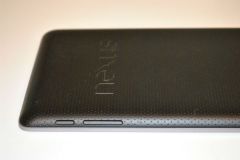I’d be lying if I said my decision to attend Google’s I/O conference last month had nothing to do with the tablet rumors. I’ve been waiting for a good, affordable 7-inch tablet ever since Samsung pioneered the concept with its original Galaxy Tab in 2010, but every small tablet since then has suffered from some fatal flaw, such as weak battery life, outdated specs or a high price. The possibility of a Nexus tablet announcement was intriguing.
Google announced the Asus-built Nexus 7 as expected, and it’s the first 7-inch tablet to hit all the right notes, including a quad-core processor, a 10-hour battery, and a finely-tuned version of Android known as Jelly Bean. Unlike Amazon’s Kindle Fire, the Nexus 7 includes all of Google’s own apps and the full Google Play Store. But like the Fire, it has a killer price: $200 for the 8 GB version, and $250 for 16 GB.
(MORE: Google’s Nexus 7 and Nexus Q: A Photo Tour of the New Hardware)
From Google I/O through the first half of July, I used an 8 GB Nexus 7 that Google gave away to everyone at the conference. After that, I bought a 16 GB model for myself. (I’ll return the original to Google.) As you might guess, I’m happy with the Nexus 7.
Rather than add another straightforward (and positive) review to the heap, I thought I’d share some observations after a solid month of use:
A Bit Phone-Like, for Better and for Worse
For the Nexus 7, Google didn’t just slap on the same interface that it uses for larger tablets. Instead, the Nexus 7’s home screen is more like an overgrown Android phone, with a tray for your six favorite apps at the bottom, and a notifications bar that slides down from the top. This was the right call, because it reduces the learning curve for anyone who has used an Android phone but still allows more room for apps and widgets. Just one big nuisance: You can’t rotate the home screen to landscape mode without third-party apps or alternative launchers, so if you’re switching from one landscape app to the next, you’ll have to twist the tablet or tilt your head.
The App Situation: Not Terrible
Android isn’t known for its vast selection of apps optimized for tablets, but on a 7-inch screen, I was expecting to rely mainly on blown-up smartphone apps. To my surprise, some of my go-to apps already look good on the Nexus 7, including Pulse, Pocket and Netflix. It helps that Google has made its own apps look great, and tablet optimizations are a non-issue for gaming (though some games like Minecraft and Zynga Poker have some big-screen tweaks as well). I’d still kill for a true tablet version of Yelp, but overall I’m satisfied with the app situation.
 Hey, It’s a Creation Device!
Hey, It’s a Creation Device!
By now, plenty of pundits have debunked the idea that the iPad’s for consumption, not creation. Fewer people seem interested in defending the productivity chops of a 7-inch tablet like the Nexus 7. And yet, when I need to jot down some ideas and I’m not at my desktop PC, I reach for the Nexus 7 every time. That’s because thumb-typing is much easier on the smaller screen than it is on the larger iPad. I’m now in the habit of throwing some thoughts into the Google Drive app, so my notes are waiting for me when I’m back at the desktop.
The 16 GB Model’s an Easy Upsell for Gamers
If I had stuck with the 8 GB version of the Nexus 7, I’d be almost out of storage space already. I’m not storing any music or videos on the device–I stream them instead–but games like Shadowgun and Grand Theft Auto III are huge storage hogs, and the 8 GB model only has about 5.3 GB of actual storage space. Buyers should splurge on the larger model unless you’re only planning to install a handful of apps and little else.
Android Can Still Get in the Way
As I wrote in my Android 4.1 Jelly Bean overview, Google’s operating system makes some big leaps forward in usability and smoothness. Sometimes I catch myself just scrolling back and forth on the home screen admiring the responsiveness. But things can still get weird. In one instance, an app caused everything to get choppy and slow until I dug into system settings and force-closed the offending program. I’ve experienced a few app crashes, and some websites can get laggy, particularly desktop-optimized ones. Granted, I’ve had some of the same issues on the iPad, but in general iOS still seems a little better at getting out of the way.
MORE: Jelly Bean Impressions: Android’s Most Important Update Yet

